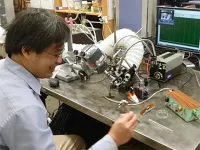(Press-News.org) It has long been known that exposure to pesticide sprays is harmful to honey bees. In a new study, researchers have uncovered the effect of such sprays on the sense of smell in bees, which could disrupt their social signals.
Honey bees live in dynamic communities and constantly communicate with each other using chemicals that serve as social cues. For example, nurse bees—that are responsible for taking care of larvae that ultimately become queens and worker bees—constantly monitor the larvae using in the dark using pheromones. The larvae emit brood pheromones to indicate that they need food. There are also alarm pheromones that workers produce to warn the other bees of danger. If these cues are dampened or not perceived properly, the colony may fail to thrive.
Since 2007, scientists have known that honey bees have been in trouble. One of the stressors that have raised concerns are insecticides, which affect honey bee health. Because these are usually used in combination with other chemicals, the resulting mixture can become unexpectedly toxic to bees.
“For many years, it was assumed that fungicides do not have an adverse impact on insects because they are designed for fungal targets,” said May Berenbaum (GEGC/IGOH), a professor of entomology. “Surprisingly, in addition to insecticides, fungicides also have an adverse effect on bees and combining the two can disrupt colony function.”
For more than a decade, reports originating from almond orchards, where two-thirds of the U.S. honey bees are transported every year when the flowers are in bloom, implicated pesticide spray mixtures. In particular, the problem lies in the use of supposedly inactive chemicals called adjuvants, which increases the “stickiness” of the insecticide so it stays on the plants.
Because adjuvants have long been considered to be biologically benign, they are not subject to the same level of safety testing as other insecticidal agents. “Recently, researchers have shown that adjuvants alone or when used in combination with fungicides and insecticides are toxic to bees,” Berenbaum said.
Nurse bees are especially vulnerable to these combinations. “The health of the queens is paramount,” Berenbaum said. “If healthy queens are not produced, the colony can suffer.”
To understand how combinations affect nurse bees, the researchers tested their effect on the olfactory system of honey bees using the adjuvant Dyne-Amic, the fungicide Tilt, and the insecticide Altacor.
The researchers divided bees into four groups of ten bees and for a week exposed them to either untreated commercial pollen or to pollen that had been treated with either Dyne-Amic, or Tilt and Altacor, or all three together. The bees were then anesthetized on ice and one antenna was carefully removed from each bee. The researchers then exposed the antenna to chemical mimics of brood and alarm pheromones and recorded the antenna’s response using a technique called electroantennography.
With this method, Ling-Hsiu Liao, a research scientist, and Wen-Yen Wu, a graduate student, in the Berenbaum lab, found that when nurse bees had consumed pollen contaminated by the three chemicals, their antennal responses to some brood pheromones and alarm pheromones were altered. Their finding suggests that these commonly-used pesticides can interfere with honey bee communication.
How these chemicals interact and influence the bees is still unclear. “There are many possible explanations for how consuming these chemicals can affect the sensory responses of bees,” Liao said. “The antenna detects and triggers the response to olfactory signals. In this study we did not look at what other changes are triggered, particularly changes in behavior.”
In addition to parsing out the underlying molecular pathways that are affected, the researchers are also interested in testing other mixtures of commonly used pesticides as well as looking at the response of bees in other populations. They hope that their work can help beekeepers rethink how they manage and protect their colonies.
The study “Effects of pesticide-adjuvant combinations used in almond orchards on olfactory responses to social signals in honey bees (Apis mellifera)” was published in Scientific Reports and can be found at https://doi.org/10.1038/s41598-023-41818-7. The work was supported by the Almond Board of California, the USDA-AFRI National Institute of Food and Agriculture, Ohio State University, and the University of Illinois Urbana-Champaign.
END
Pesticides and adjuvants disrupt honey bee’s sense of smell
2023-12-15
ELSE PRESS RELEASES FROM THIS DATE:
Immune cells shape lung before birth and provide new avenues for treating respiratory diseases
2023-12-15
Immune cells play an active and intimate role in directing the growth of human lung tissue during development, researchers find, revolutionising our understanding of early lung development and the role of immune cells outside of immunity.
The research offers new insights for understanding and treating respiratory conditions, such as chronic obstructive pulmonary disease (COPD). Respiratory conditions account for almost 20 per cent of all deaths in children under five years worldwide1.
The work reveals a surprising coordination between the immune and respiratory systems, much earlier in development than previously thought. This discovery raises questions about the ...
Rembrandt broke new ground with lead-based impregnation of canvas for The Night Watch
2023-12-15
New research has revealed that Rembrandt impregnated the canvas for his famous 1642 militia painting ‘The Night Watch’ with a lead-containing substance even before applying the first ground layer. Such lead-based impregnation has never before been observed with Rembrandt or his contemporaries. The discovery, published today in Science Advances, underlines Rembrandt's inventive way of working, in which he did not shy away from using new techniques.
The surprising observation is yet another result from Operation Night Watch, the largest and most wide-ranging research and conservation project in the history ...
SFU and UBC researchers receive $1.25 million to study cumulative effects on B.C. salmon
2023-12-15
Salmon researchers from British Columbia are embarking on a three-year study to understand and help mitigate the cumulative threats affecting the vulnerable species in the province’s watersheds.
The Watershed Futures Initiative, which includes researchers from Simon Fraser University, University of British Columbia and University of Montana, has received $1.25 million from the federal and provincial governments – through the joint British Columbia Salmon Restoration and Innovation Fund – to tackle the combined impacts of logging, mining, urban development, agriculture, climate change and other factors on salmon.
While ...
Endocrine-disrupting chemicals found in menstrual products including tampons, pads, and liners
2023-12-15
The average menstruator will use over 11,000 tampons or sanitary pads in their lifetime. Vaginal and vulvar tissue that touch pads and tampons is highly permeable. Through this permeable tissue chemicals are absorbed without being metabolized, which makes endocrine-disrupting chemicals potentially dangerous when found in menstrual products. Endocrine-disrupting chemicals can interfere with human hormones and cause medical issues, including gynecological conditions such as endometriosis and uterine fibroids.
Joanna Marroquin, a Mason PhD in Public Health student, and Associate ...
Five researchers named Argonne Distinguished Fellows for 2023
2023-12-15
The U.S. Department of Energy’s (DOE) Argonne National Laboratory has named five highly accomplished scientists as Argonne Distinguished Fellows in 2023. They are Glenn Decker, Paul Fenter, Robert Fischetti, Sven Leyffer and Valentine Novosad.
The honor recognizes scientists who have not only achieved international esteem but who have also demonstrated exceptional achievements in science or engineering relevant to Argonne’s core missions. They are leaders of major, complex, high-priority projects or programs that have an impact on the future of the Laboratory. Only a small ...
Study shows exposure to household chemicals can lower odds of getting pregnant
2023-12-15
Exposure to phthalates, a group of plasticizing and solvent chemicals found in many household products, was linked to a lower probability of getting pregnant, but not to pregnancy loss, according to research by a University of Massachusetts Amherst environmental and reproductive epidemiologist.
The study, published this week in the journal Environmental Health Perspectives, also noted an association between preconception exposure to phthalates and changes in women’s reproductive hormones, as well as increased inflammation and oxidative stress.
“Phthalates ...
NRL’s Debra Rolison elected 2023 National Academy of Inventors Fellow
2023-12-15
WASHINGTON – Debra Rolison, Ph.D., of the U.S. Naval Research Laboratory (NRL) has been named Fellow of the National Academy of Inventors (NAI), for having demonstrated a highly prolific spirit of innovation in creating and facilitating outstanding inventions that have made a tangible impact on the quality of life, economic development, and welfare of society.
Rolison has been at the lab for over 43 years and heads the Advanced Electrochemical Materials section. The recognition by the NAI is attributed to the efforts made by her team’s inventions related to a new form factor for zinc anodes in rechargeable ...
North America’s first people may have arrived by sea ice highway
2023-12-15
SAN FRANCISCO — One of the hottest debates in archeology is how and when humans first arrived in North America. Archaeologists have traditionally argued that people walked through an ice-free corridor that briefly opened between ice sheets an estimated 13,000 years ago.
But a growing number of archeological and genetic finds — including human footprints in New Mexico dated to around 23,000 years old — suggests that people made their way onto the continent much earlier. These early Americans likely traveled along the Pacific coastline from Beringia, the land bridge between Asia and North America ...
Xinfeng Gao named 2024 AIAA Associate Fellow
2023-12-15
We are pleased to announce that the American Institute of Aeronautics and Astronautics (AIAA), a preeminent aerospace professional society, has selected professor Xinfeng Gao to be a member of the class of 2024 AIAA associate fellows. Only one member of the Institute for every 150 members is selected as an associate fellow each year by the review committee.
“This recognition illustrates the impact of our outstanding faculty. Aerospace engineering at UVA continues on a great trajectory and professor Gao is a big part of that,” said Richard W. Kent, professor and chair of the Department of Mechanical and Aerospace Engineering.
Pioneering ...
Substance-abuse stigma impedes treatment in various ways, scientists say
2023-12-15
Addiction is one of society’s most misunderstood and rebuked health conditions. That stigma discourages many people from seeking treatment for substance dependence, according to a new report published in Psychological Science in the Public Interest, a journal of the Association for Psychological Science.
Research on stigma toward people with substance use disorder (SUD) is relatively sparse, the report adds.
“Characterizing the nature and etiology of SUD stigma is critical for developing tailored and effective interventions ...






